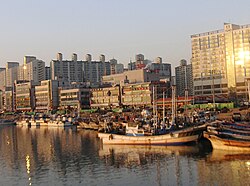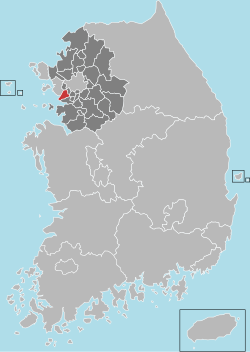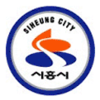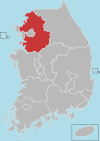Siheung
Siheung
시흥시 | |
|---|---|
| Korean transcription(s) | |
| • Hangul | 시흥시 |
| • Hanja | 始興市 |
| • Revised Romanization | Siheung-si |
| • McCune-Reischauer | Sihŭng-si |
 Wolgot Harbor past Oido Station | |
 Location in South Korea | |
| Country | |
| Region | Sudogwon |
| Administrative divisions | 11 dong |
| Area | |
| • Total | 135.79 km2 (52.43 sq mi) |
| Population (2017) | |
| • Total | 472,162 |
| • Density | 3,355.8/km2 (8,691/sq mi) |
| • Dialect | Seoul |
Siheung Korean: [ɕi.ɦɯŋ] is a city in Gyeonggi Province, South Korea.
In the early Three Kingdoms period, the Siheung area was part of the Baekje kingdom. It was lost to Goguryeo along with the Han River valley in 475.
Siheung acquired its current administrative identity on January 1, 1989, when the old county of Siheung (Siheung County) was divided into the cities of Siheung, Gunpo, and Uiwang. At the time Siheung city had a population of only 93,000. This number more than tripled in the following decade, as massive suburban apartment complexes were developed.
Today's Siheung City area belonged to old Incheon and Ansan before 1914.
Notable landmarks include Oi Island, Mount Sorae, and the port and inlet of Wolgot. Siheung includes two new cities that were developed in the 1990s, Sihwa and Wolgot New City. The new city of Sihwa includes a very large industrial complex. Companies headquartered there include Hansung Machinery Co. Korea Polytechnic University established in 1997, and also Kyonggi Institute of Technology established in 1998.
In 2006, Korea Polytechnic University built TIP (Techno Innovation Park). The building has 18 floors used for studying, research, and development for students, faculty, companies and government.[1]
In February 2010 Seoul National University acquired 826 thousand square-meters or 204 acres of Siheung property to establish its global campus.[2] The university plans to build a bio-medical complex, research hospital, apartments, and education-related infrastructure including lecture halls, dormitories, and an international middle and high school.[3]
Administrative districts
Siheung-si is divided into 18 dongs.[4] As of 2017, the population of the city is 419,664 people including 167,802 households.
| Administrative dong | Korean name | Area(km²) | Population | Household |
|---|---|---|---|---|
| Daeya-dong | 대야동 | 9.85 | 31,276 | 12.860 |
| Sincheon-dong | 신천동 | 3.44 | 38.566 | 17,898 |
| Sinhyun-dong | 신현동 | 12.64 | 10,712 | 4,396 |
| Eunheng-dong | 은행동 | 5.96 | 44,233 | 15,278 |
| Maehwa-dong | 매화동 | 11.20 | 12,848 | 5,133 |
| Mokgam-dong | 목감동 | 17.57 | 40,586 | 15,795 |
| Gunja-dong | 군자동 | 16.69 | 23,735 | 9,738 |
| Wolgot-dong | 월곶동 | 8.53 | 15,358 | 6,859 |
| Jeongwangbon-dong | 정왕본동 | 8.83 | 21,720 | 14,016 |
| Jeongwang 1-dong | 정왕1동 | 6.55 | 23,869 | 13,085 |
| Jeongwang 2-dong | 정왕2동 | 5.55 | 32,536 | 12,516 |
| Jeongwang 3-dong | 정왕3동 | 6.18 | 23,894 | 10,881 |
| Jeongwang 4-dong | 정왕4동 | 5.80 | 22,289 | 7,438 |
| Baegot-dong | 배곧동 | 4.97 | 68,084 | 25,421 |
| Gwarim-dong | 과림동 | 7.65 | 2,069 | 1,247 |
| Yeonseong-dong | 연성동 | 10.05 | 23,368 | 8,283 |
| Janggok-dong | 장곡동 | 3.49 | 17,832 | 5.606 |
| Neunggok-dong | 능곡동 | 4.34 | 17,156 | 6,946 |
| Total | 시흥시 | 135.79 | 472,162 | 186,443 |
Transportation
Railroad
- Oido - Darwol - Wolgot → (Namdong-gu)
- Seohae Line New subway line built in June 16, 2018.
- Siheung Deya - Sincheon - Sinhyeon - Siheung City Hall - Siheung Neunggok are running in Siheung-si.
Industry
Gross Domestic Product
The total regional production of Siheung City in 2012 is 26.888 billion won. It accounts for 3.6% of Gyeonggi Province's GDP. The agriculture and forestry industry (primary industry) is low at 41.4 billion won. Mining and manufacturing (secondary industry) accounted for 16.24 trillion won, accounting for 64.2%, while commercial and service industry (tertiary industry) accounted for 35.6%, amounting to 9.29 trillion won. In the tertiary industry, wholesale and retail trade (6.6 percent), construction (4.0 percent), real estate and leasing (3.3 percent) and business services (3.2 percent)[5]
Status of Employees by Industry
In 2014, the total number of workers in Siheung City Industry is 185,032. It accounts for 4.1% of the total number of employees in Gyeonggi-do. The number of agriculture and forestry fisheries (primary industry) is 17, which is low. Mining and manufacturing (secondary industry) accounted for 48.4%, with 89,554 employees. The commercial and service industry (tertiary industry) accounted for 95.6%, accounting for 51.6%. Secondary industry is higher than Gyeonggi province (27.1%) and tertiary industry is lower than Gyeonggi province (72.9%). In the tertiary industry, the proportion of housing and food and lodging (7.6 percent), education (5.2 percent), and health and social services (4.4 percent)[6]
Recreation & Tourism
The Lotus Theme Park can be visited year-round by bikers and pedestrians, but the peak months for seeing the lotus plants in bloom are July and August. It is also the site of a summer festival. Seven varieties of lotus and over thirty varieties of waterlilies are cultivated at the park.[7] Admission to the theme park during the summer months is free, and lotus viewing tours take place from 9:00 a.m. to 2:00 p.m. local time.[8] The theme park can be reached by several city bus routes.[9]
- Siheung Gaetgol Ecology Park
There is inland gaetgol that is rare in the world. This gaetgol is exposed twice a day at low tide. It is called serpentinizing mudflat because it looks like snake.
Sister cities
References
- ^ "KoreaPolytechnicUniversity". www.kpu.ac.kr.
- ^ Chung, Young-jin (2010-02-12). "Plans under way for new SNU branch in Siheung". joongangdaily.joins.com. Retrieved 2011-05-05.
- ^ Kim, Yea-rim (2011-03-16). "Siheung is on the Road to Becoming Korea's Investment Mecca". koreatimes.com. Retrieved 2011-05-05.
- ^ "Siheung Administrative districts". Retrieved 13 September 2013.
- ^ "KOSIS". kosis.kr (in Korean). Retrieved 2018-04-16.
- ^ "KOSIS". kosis.kr (in Korean). Retrieved 2018-04-16.
- ^ "Archived copy". Archived from the original on 2011-10-06. Retrieved 2011-08-09.
{{cite web}}: CS1 maint: archived copy as title (link) Lotus Theme Park Info - ^ http://www.siheung.go.kr/tour/content.do?method=contentView&topCmsCd=CM0139&cmsCd=CM1764&grp=2&clickParentNum=11&clickNum=12 Siheung Lotus Theme Park Page (Korean)
- ^ "Archived copy". Archived from the original on 2011-10-06. Retrieved 2011-08-09.
{{cite web}}: CS1 maint: archived copy as title (link) Lotus Theme Park Info and Directions - ^ "韩国始兴市师生来我校游学访问交流-德州市实验小学". www.dzsyxx.com. Retrieved 2020-04-14.
- ^ "始兴市". Retrieved 2020-04-14.
{{cite web}}: CS1 maint: url-status (link) - ^ "Regular Adjourned Meeting No. 28". Archived from the original on 2010-11-29.


